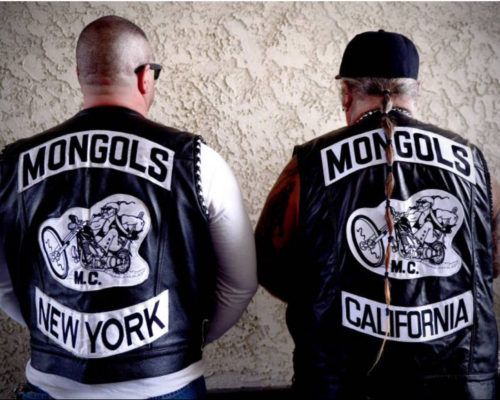Taking their name from Genghis Kahn, the Mongol Motorcycle Club has lived up to the moniker with a brutality reminiscent of the legendary warlord.
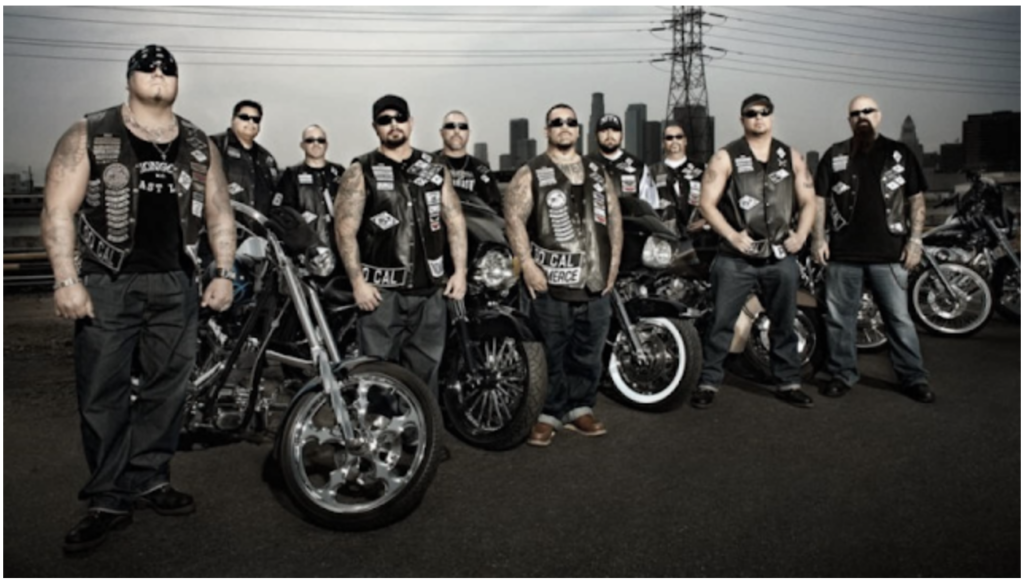
Anti-Social and violent, The Mongols motto is “Respect Few, Fear None.” Originally formed in Montebello, California on December 5, 1969, after being rejected membership into the Hells Angels due their Hispanic heritage, the 15 original mongols were military veterans who loved to ride their Harley Davidson’s. The soldiers coming home from Vietnam were looking for a niche and they found it with the formation of the club.
The club’s colors are black and white. Their patch is a member of the Mongol horde of ancient times riding a Harley Davidson motorcycle. With a heavy presence in Southern California the Mongols have grown tremendously over the years and now have chapters all over the United States and even in several foreign countries. With about 1500 club members world wide, the majority- around 800- reside in the club’s Southern California stomping grounds. What they lack in numbers they make up with continual doses of ultra-violence.
“A majority of the Mongols membership consists of Hispanic males who live in the Los Angeles area, and many are former street gang members with a long history of using violence to settle grievances,” a Bureau of Alcohol, Tobacco and Firearms (ATF) report says. The ATF considers the Mongols the most violent motorcycle club in the United States. The Mongols have allied themselves with the Bandidos, Outlaws, Sons of Silence and the Pagans to compete for territory and members with the Hells Angels, the report says.
The one percent outlaw motorcycle club, that law enforcement accuses of being a criminal syndicate, exists in an alpha male dominated culture where brotherhood, family and community is valued and cherished. A secret society members claim, but not necessarily a criminal one, despite being targeting but the federal government. Clashes with police and other biker gangs, like the Hells Angels, have cemented the Mongols reputation.
Major players in the drug trade the club has been accused of running meth, cocaine and heroin with a direct connection to the Mexican cartels. Gun running, grand theft motorcycle and other crimes like robbery, extortion, money laundering, murder, assault and firearms violations have been the club’s M.O. the feds claim. But the current president says the club is not a criminal enterprise and that they’ve changed their code of conduct, even kicking out drug abusers and criminals.
But that goes against one of the main patches they sport on their colors, “Mongols Forever, Forever Mongols.” With a presence in 14 states and international chapters in 18 countries the club gives out patches like the Boy Scouts give out merit badges. The skull patch represents criminal violence performed as a service to the club. They even have a catch all emergency signal they send out to members when law enforcement is on the prowl- Code 55- which means hide all gang affiliation and lay low because the cops are out hunting Mongols. The club has gone from party heavy disaffected Vietnam veterans to full-time criminals with ties to violent street gangs.
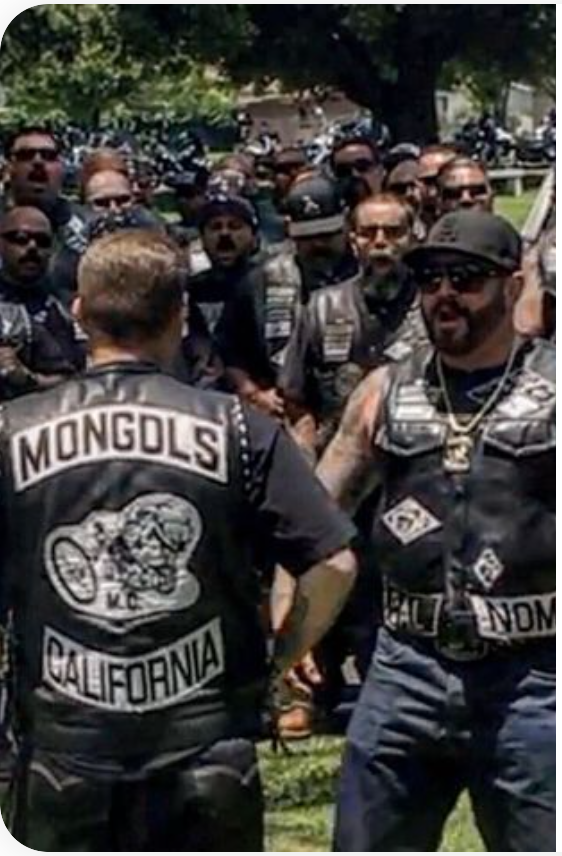
Infiltrated by law Enforcement
Undercover ATF agent William Queen infiltrated the Mongols in 1998. Going by the name Billy St. John, the agent prospected, got patched up and attained a position as chapter vice president. The ATF, through Queen, conducted over a two year investigation which led to 54 Mongols being arrested and convicted of drug trafficking, motorcycle theft and conspiracy to commit murder in 2000.
“Prospecting inside the Mongols was a dangerous game,” Queen wrote in his book Under and Alone: The True Story of the Undercover Agent Who Infiltrated America’s Most Violent Outlaw Motorcycle Gang. “According to intel developed by the ATF, the Mongols Motorcycle Club had assumed the mantel of themes violent motorcycle gang in America, a sigh-knit collective of crazies, unpredictable and unrepentant bad-asses.”
At the time the Mongols only had about 350 full members, a small number of bikers in comparison to the more notorious Hells Angels, but the Mongols were known to bring it. They’d been clashing with the Hells Angels since the 1970s. A decades long beef that was fought over who was the preeminent outlaw motorcycle club in California. As the bodies dropped law enforcement ramped up its focus on the motorcycle clubs.
“Their most significant violent acts in the 1970s and ‘80s were committed agains the Angels, with who they fought and ultimately won a seventeen-year war.” Queens writes in Under and Alone. “But by the mid-nineties, infused by the ruthless Latino gang mentality of East Los Angeles the Mongols’ indiscriminate violence spread outside the biker underworld and began to terrorize the general populace of Southern California.”
Hells Angel Beef
The war with the Hells Angels put the Mongols on the map and defined who and what they were. Here was this little upstart outlaw motorcycle gang running rampant in Southern California, the home state of the bigger and more infamous club. The Angles didn’t like the the Mongols wore a patch on their colors that said California. They told the Mongols to take it off, but the Mongols refused. What started off as fights, drunken brawls and stabbings turned into shootings and bombings, where seemingly nothing was off limits.
The two clubs were engaged in a vicious back and forth beef where bars and hangouts were bombed, members were executed and their was bad blood on both sides. Finally the two sides got together and called a truce. The Mongols were given Southern California and the Angels would stick to their northern roots. The Mongols had vanquished the bigger and badder club. The Mongols had won the war but they’d lost many members, so they opened the books again and started recruiting.
In 2002 the much publicized confrontation between the Mongols and Hells Angels jumped off at Harrahs Casino in Laughlin, Nevada. It was a new era of warfare between the two bitter rivals that had been sparked by the Mongols starting a chapter in San Jose. According to the pact Northern California was Hells Angels territory and the Mongols violated the truce with their movement into the Angel’s turf.
Three men were left dead at Laughlin. Two Hells Angels- Jeramie Bell, 27-years-old and Robert Tumulty, 50-years-old were shot and killed during the violent outbreak- and one Mongol- Anthony “Bronson” Barrera, 43-years-old was stabbed to death. Six Mongols and six Hells Angels were convicted and sent to prison for being involved in the incident. Thirty-six others had the charges dropped. Over 50 knives and multiple guns were taken into evidence by police. A video replay of the incident shows that during the confrontation the Hells Angels through the first blow.
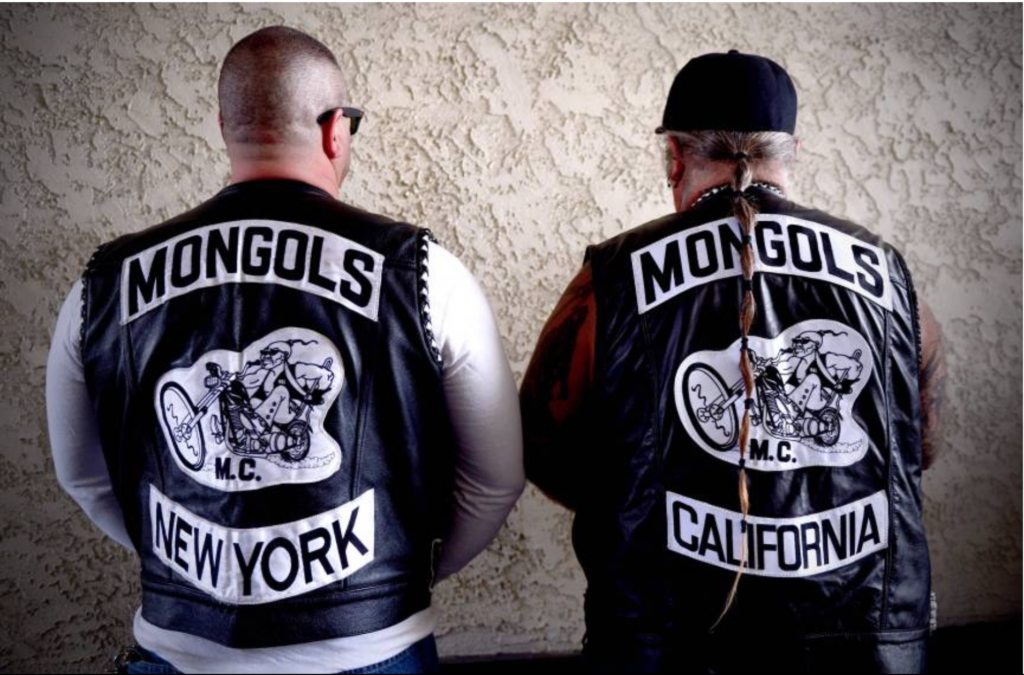
The New Boss
Ruben “Doc” Cavazos seized control of the Mongols MC after Laughlin. He became the National President. Old school members laid the blame at his feet for transforming the Mongols into a criminal organization, one of the largest on the West Coast. His brother, Al “the Suit” Cavazos and his son, Ruben “Lil Rubes” Cavazos Jr. were instrumental in helping him to take over the club. Before he took over every member had to own and ride a Harley Davidson, but Doc ignored that prerequisite to recruit Hispanic street gang members. These new members bypassed the prospect ritual and joined as part-time Mongols.
Doc had a tumultuous and high profile run as the Mongols MC National President. He oversaw and participated in the filming of Mongol Nation, an episode of the History Channel’s Gangland Season 2, while he was also being investigated by the ATF in Operation Black Rain which eventually led to 110 arrest warrants being issued in October 2008 for Mongol members in California, Colorado, Nevada, Washington and Oregon. The feds infiltrated the Mongols for a second time and the undercover ATF agents became patched members again. Cavazos and others pled guilty to racketeering charges and America’s Most Wanted had unrestricted access to the operation and filmed many of the arrests.
Doc admitted that he “led a murdering, drug dealing criminal conspiracy called the Mongols Motorcycle Club” and that “the Mongols Registered Trademarks afforded a source of influence over the RICO enterprise that defendant admits he established, operated, controlled, conducted and participated in”. Police raided his 2,760 square foot home in South Hills, West Covina and seized an arsenal of guns and bullet proof vest. Doc was handed a 14 year sentence by the feds after becoming a government informant.
The website of his former club had this to say about their ex-National President. “Ruben “Doc” Cavazos flipped on January 23rd. He seems to have gone quickly and easily.” The website states. “He was the very first Mongol to plead guilty to count one of the indictment. As part of his guilty plea Cavazos agreed to the forfeiture of all right, title and interest in certain assets acquired or maintained by him as a result of his violation of the RICO statute including the Mongols Registered Trademarks.” Admitting that the trademarks were subject to forfeiture to the United States. During a meeting in Vernon, California on August 30, 2008, Doc was voted out of the club due to the majority of the membership believing that he was stealing from the club and provoking a war with the Mexican Mafia.
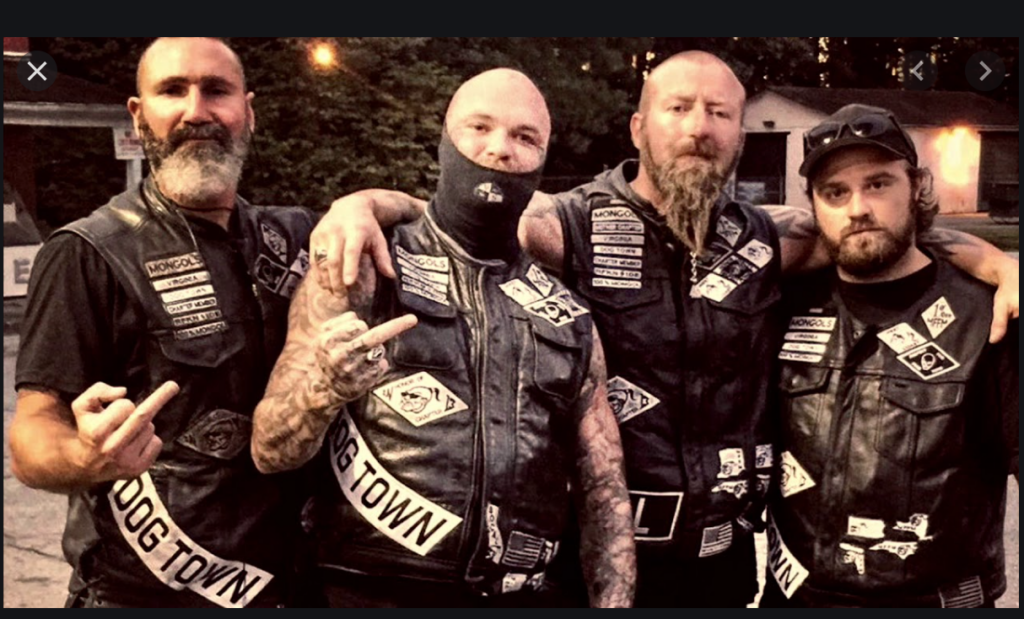
Mexican Mafia Beef
“We are what everybody fears,” Doc’s son Lil Rubes said on the Mongol Nation Gangland episode, but super gang La Eme, better known as the Mexican Mafia, didn’t fear the Mongols MC at all. In March 2004 the outlaw motorcycle gang and the prison gang were ready to go to war over pride and respect after a series of meetings set up to keep the peace fell apart. The beef started over the discovery of a meth lab by police that the Eme blamed the Mongols for.
The Eme told the mongols that they had to pay the tab for the discovered lab. Production was halted, equipment was confiscated and the Eme shot callers in prison lost a viable income stream. On top of having the Mongols paying for the lab the Eme decided that the Mongols had to pay a cut of their drug proceeds as a drug tax to the prison gang. The Eme brought the demands to Doc and he brought them to the club.
Everyone said, “Fuck it, we’ll go to war.” But the Mongols MC didn’t know what they were getting into. The Eme controls the Surenos and held tens of thousands of soldiers in the streets ready to do their bidding. The Mongols became targets and gun battles erupted all over East Los Angeles. Vans full of Surenos would open fire on Mongols on the highway. Plus the beef with the Hells Angels was still jumping off too.
Doc was fighting a battle on two fronts at the time, dodging assassinations attempts. His fellow MC members would search his car before starting it because they thought he was going to be blown up. It got so bad that Mongols stopped wearing their colors. When war broke out the the Eme the Mongols lost over 20 members. Finally a payment was made to end the bloodshed. But the writing was on the wall. Many old school Mongols blamed Doc and these issues lingered until he was kicked out of the MC.
Trademark Case
US District Court Judge Florence-Marie Cooper issued an injunction from the court that prohibited club members, family members and associates from wearing, licensing, selling, or distributing the the Mongol logo, because according to law enforcement, the logo and name were used to identity the club and as a form of intimidation to fulfill their goals. This was an extension of the ATF’s 2008 Operation Black Rain. With the Mongol MC President Doc admitting that the logo was used to further the criminal enterprise the feds were making an unprecedented move.
The government cited the guilty pleas to Count One of the Indictment by numerous defendants besides Cavazos as proof that the Mongols Motorcycle Club was a criminal conspiracy and the name and patch were subject to forfeiture. The government argued that the pleas demonstrated “a nexus between the violation of which the defendant has been convicted (or to which he has pled) and the property sought.”
The Mongols started holding rallies to bring awareness to the federal lawsuit targeting the club logo. After much back and forth the case was finally settled on September 16, 2015 when Federal District Judge David O. Carter, a judge in Los Angeles, ruled against the forfeiture of all rights that the club had in regards to emblems and patches. He dismissed the case and injunction.
The Mongols MC has continued to be in the news as recently as January of this year, when they had an encounter with the Iron Order MC and a Mongol member, Victor Mendoza, was shot and killed in Denver, Colorado as the situation escalated. The Iron Order, an MC of mostly retired police officers, claims the shooting was in self-defense but the Mongols, in a very questionable move for a outlaw motorcycle club, denounced that theory in a press conference where they claimed Mendoza was murdered.
Despite all the negative press surrounding the club they have continued to grow, especially internationally. The Mongols MC also continued their flirtation with the press when they invited Lisa Ling from CNN to join them for a few days. She documented and captured on film how the Mongols MC is harassed and profiled by law enforcement. The CNN special, titled This is the Life aired on October 7, 2015 further enhancing the already mythical legend that the Mongols MC enjoys.



